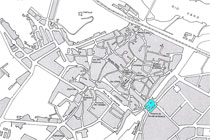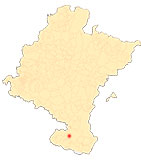place Nueva de Tudela
By Esther Elizalde
The place as a link between the old city and the modern city
Traditionally, bullfights were held at the "place Vieja" or "place de las Verduras" but the Cabildo prohibited this entertainment as it was sacred ground because it was the cemetery of the Parish of Santa Maria. As a solution, the Regiment decided to create a place for bullfights and other religious and civil events. To achieve this it was necessary to break the wall, converting the new place into a road collector and a link between the old city and the subsequent expansion of the riverside capital. Moreover, it meant a "bridge to the future" by making possible the expansion of the city beyond the limits of the wall, giving rise to the modern city. Likewise, it also acquired the function of "conference room of being" for the people of Tudela.
MARTÍNEZ ESCALADA, J.: La historia de Tudela contada por sus calles, Zaragoza, 1999.
GARCÍA GAINZA, M.C., HEREDIA MORENO, M.C., RIVAS CARMONA, J. and ORBE SIVATTE, M.: Catalog Monumental de Navarra. I. Merindad de Tudela, Pamplona, Institución Príncipe de Viana, 1980.
Catalog of the exhibition 120th anniversary of Tudela (802-2002): La cultura en Tudela a lo largo de su historia, Tudela, 2002.
A.A.V.V.: Ibaiak eta Haranak. guide del patrimonio artístico y paisajístico. Vol. VIII. Navarra, San Sebastián, Etor, 1991.
YANGUAS Y MIRANDA, J.: Diccionario histórico-político de Tudela, Zaragoza, 1828.
SAINZ PEREZ DE LABORDA, M.: Apuntes tudelanos, Tudela, 1969.
TARIFA CASTILLA, Mª.J.: La arquitectura religiosa del siglo XVI en la Merindad de Tudela, Pamplona, Gobierno de Navarra, department de Education y Cultura, Institución Príncipe de Viana, 2005.












